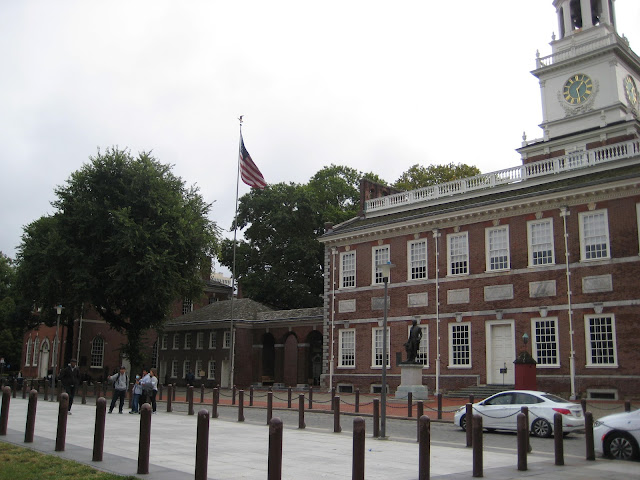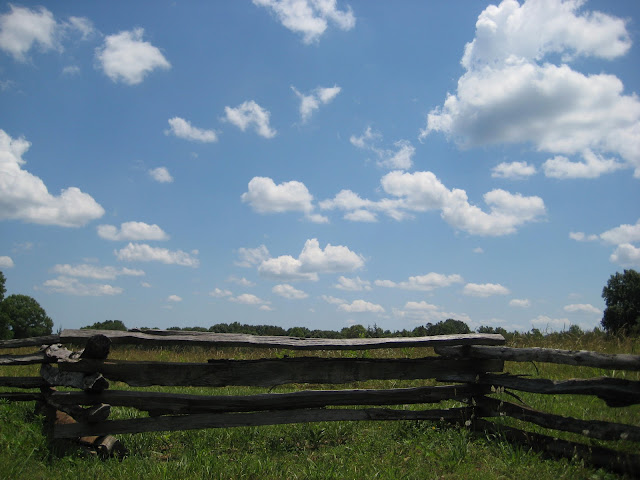October 5-7
Wednesday, the fifth, was Yom Kippur, Kate’s birthday, and our day to visit the Liberty Bell.
The bell used to sit inside Independence Hall, but some time in the past few decades, it has been moved to its own museum across the street on a block now known as Independence Mall.
It is a short walk from the hotel. There was still a threat of rain and a chill in the breeze, so we took the umbrella for a walk.
When we got there, we were confronted by another of those local-airport style checks, like Independence Hall. The sign says “no weapons” and that included firearms and pocket knives.
Whoops. I forgot to leave mine home this time. Not firearm. I don’t own one. I’m so absent-minded I’d likely shoot myself in the foot.
So I went up to a uniformed person and showed her my switchblade. Can I check it somewhere and pick it up when I leave?
She took it and said she would check. She came to me when I was with Joanna in line and said she had given it to a colleague, a man in the same kind of blue shirt as hers. When I passed the check point he would give it back to me.
This was almost as much fun as the time I walked into the Vatican Museum with a brand new stiletto in my pocket. The metal detectors weren’t even working there.
This time I passed through and was putting my belt and jacket back on when the guy standing nearby hears me tell Joanna that I have to find the officer with my knife. He discreetly dropped it into my hand.
Maybe they took one look at me—white stubble and pony tail. They may have figured I was the ghost of George Carlin. “Let him do as he damn well pleases.”
Like many famous objects, the Liberty Bell has a lot of iffy history. Much of the stuff that people have assumed or have made up about it has managed to stick.
There’s no proof, for instance, that the bell rang when the States declared independence. It was in the belfry of the Statehouse, which wasn’t yet called Independence Hall, so it could have been used in the celebration.
But it’s an assumption. Believing it makes the bell a great symbol.
The bell’s home is the Quaker City, which became a front-line base of the U.S. anti-slavery movement. It was a base of operations for Harriet Tubman. The abolitionists used the bell and its yet-to-be-complete promise of liberty as an icon to pique the consciences of the American people.
It was also a symbol of the Women’s Suffrage movement. In 1915, one exhibit says, a Suffragist had a replica made and said it would ring the first time when Pennsylvania granted women the right to vote.
The original Liberty Bell cracked three times. The first was in 1751 during a test after the bell arrived from London.
The bell was recast by a local foundry. And that’s when it got the inscription taken from Leviticus: “Proclaim Liberty Throughout All the Land Unto All the Inhabitants thereof.”
It’s a reference to the Jubilee every 50 years when, ironically enough, activities include the freeing of slaves.
There’s no record of when the second crack developed.
That crack wasn’t repaired so much as treated. According to the National Park Service, the plan was to drill the crack wider. That would return much of the bell’s tone because the rough edges of the original crack wouldn’t rub together.
This was apparently a standard technique for restoring cracked bells.
There are two stories about when the final crack rendered the bell unringable.
One is that it rang to announce the death of Chief Justice John Marshall, who died in 1835 in Philadelphia, where he had come for medical treatment. That’s the story I heard in grammar school.
The Park Service web site said the crack treatment took place later, in the 1840s. The fatal crack may have occurred during a peal for Washington’s birthday that year.
There were a few films among the exhibits. One contained a short segment about the ringing of the Liberty Bell as a morale builder during a World War II radio broadcast.
It showed a family listening to the radio and then it cut to a film clip of a man tapping a small sledge hammer against the base of the bell.
It’s only a little more than a half mile from the Liberty Bell to Reading Terminal Market.
We wanted to go there because we had heard about it and have been to markets like it in Europe, Asia, and the States. They are always fun.
We also wanted to follow up on a tip that Scott had passed along at Tuesday night’s dinner. He strongly recommended the sandwiches at Hershel’s, a deli in the food court at the center of the market.
We took our time. We walked through a possible drug market, appropriately on Market Street, a couple of blocks from the Reading Terminal. What I saw was a dozen or so streetwise looking men milling about a bus stop. One man, sitting on a plank with his back to the road, counted a sheaf of currency and then drew something out of a plastic bag at his side.
The market is crowded with stalls selling meats, fish, pizzas, herbs, home furnishings, produce and what all. The aisles are a little wider than those in the market at Chungking Gardens, but still, you can see that space is valuable here.
We found Hershel’s easily enough, but I made a mistake. I didn’t watch closely at what the customer ahead of me got. I ordered two sandwiches—one pastrami and one corned beef, both on rye with mustard. That and a pint of still water.
By the time the countermen had finished slicing up the brisket, it looked like they’d put half a softball made out of red meat on each sandwich. So much fat, salt, and red meat, downright sinful. We knew before we started that we would have to go to bed without supper.
The sandwiches were good, and we eventually got through most of them. I left two or three ounces of filling. Joanna left maybe a quarter of her sandwich.
Even more interesting, though, were the two guys who sat down next to us. They were supposedly talking to each other, but were loud enough that even I could hear them over the background noise of the market.
They could have been in their 50s, maybe even 60s. They started talking about ethnicity. One I gather was Puerto Rican. The other guy told him he didn’t look Puerto Rican, but looked German. “I used to work with Germans,” he said by way of explanation.
Later the German-looking Puerto Rican guy mentioned his ex-wife, who he believes is into Santaria or something like it. In any event, it’s the devil, he said.
He said his ex put a hex on him.
The man who worked with Germans said he’s familiar with hexes too. One time, he said, he refused to “have relations” with a man who dressed like a girl. He woke up in the middle of the night having weird symptoms of some kind.
Yeah, that’s how it goes, the other agreed.
The hexed man finally met a minister who gave him a prayer. They read a psalm together.
Later, I was thinking about all this. There are two old guys. Not as old as I am, maybe, but up there nonetheless. One of them even mentioned that he had gone to college. Maybe both of them had.
Could they really have been serious? If so, why were they so loud? Was it a leg pull? Maybe they’re performance artists.
Joanna and I made the walk back, a mile or so. We were beat, but we made it to the hotel with only a couple of brief stops to rest on the way.
Wednesday the hotel serves wine and cheese in the afternoon. A glass of cab and a handful of grapes were a perfect restorative after a workout like that.
Of course, we went to bed early. Without dinner.
Thursday we set out in a taxi for the Philadelphia Museum of Art.
All went according to plan until we tried to get in. There was a picket line protesting the lack of a contract.
A polite woman came up to us. The staff is on strike and is asking people not to go into the museum today.
We settled for an interesting stroll around the building. A sign says it was designed by Julian Abele, the first black graduate of the University of Pennsylvania School of Architecture.
It sits on a hill like an acropolis. I has colored friezes, bronze griffins, soaring columns, and all those steps that Rocky had to run up.
People at the base of the hill were setting up for the J.P. Morgan Corporate Challenge, a 5-kilometer run that was due to start at 6 p.m. One of the people in a booth said it would involve a thousand runners.
Maybe because of the event, it was only a little after three and traffic was piling up. Or maybe it’s like that every day.
There’s no way a cab was going to find us in this mess.
We walked maybe half a mile eastward, back toward our hotel, before the heat of the day and the walking of yesterday caught up to us. We found benches at a corner and I phoned 215-Get-A-Cab.
We’ll be easy to find, I said. I was the only guy with a pony tail and she’s the only Chinese lady sitting on a park bench at the corner of 21st Street.
The car showed up less than 10 minutes later.
We tried Glory Beer Bar & Kitchen for dinner. We shared two entrees. One was a lamb shank with spicy collard greens and pureed potatoes. The other was an assortment of three kinds of wurst with spaetzle and sauerkraut.
It was terrific. The lamb was falling off the bone. The collards were nice and hot, and the potatoes helped control the heat. Sausage is one of my major food groups. The spaetzle was almost like little croutons. Never had it like that before. The sauerkraut added a probiotic to our diet.
The beer list was surprising. I didn’t recognize most of the American drafts, and the imports were entirely unknown to me. What’s a Gueuze, for instance? I looked it up. You mix a year-old lambic with a two- or three-year-old lambic for a special effect.
I had three American craft IPAs. The first was Zombie Dust, hoppy enough, but light on the malt. Joanna liked that one best and finished half of mine while I went on to the other two
One that Chris the bartender called Revision Metal is a mildly sour IPA. The Revision Brewing web site doesn’t mention a brew of that name. It was excellent with the collards.
Hill Farmstead’s Susan, according to the company’s web site, is an American IPA brewed with hops from Yakima Valley and New Zealand.
All the ales were good. Susan may have been my favorite of the trio.
We were tired from walking in the heat so we took our time Friday morning and left the hotel shortly after noon. We were at Joanna’s house in Montclair before three.
Happy trails to all and to all a good night.
Love.
Harry and Joanna
Trees
























